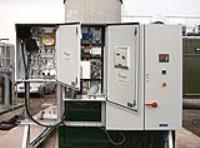 Add My Company
Add My Company
Sign In

Remote and wireless monitoring technology to meet CDM requirements is in its infancy in Europe. Carbon trading is driving it globally, especially in North and South America. That experience and technology is now finding a demand in Europe and Asia in landfill, biogas from food and animal waste in digesters and water treatment sludge digestion.
Methane recovery from landfill and anaerobic digesters is a targeted goal for green house gas reduction. Methane is known to be twenty-one times more destructive to the ozone layer than carbon dioxide and can be used effectively as an alternative fuel source for generating electricity. Landfill and other biogas processes have been under fire to dispose of the gas responsibly. In countries where environmental regulation is a serious commitment there are mechanisms in place to encourage the capture, destruction or use of the gas. In many of these areas, the processes are mature with entire technologies developed specifically for these environmental industries.
Because of a growing sense of urgency and public awareness of the effects of global warming, other regions are responding with interest.
The interest is driven by the availability of outside investor funding and the potential to develop alternative energy sources. Faced with limited exposure to modern methods of landfill or biogas recovery and utilisation, these developing regions seek seasoned and experienced talent from more developed countries. Ironically, the field of biogas recovery is still burgeoning, even in developed nations. Because this field is a niche segment of the larger energy market there is not a wealth of available talent to expand the market as demanded.
Making best use of technology to monitor operations from around the globe enables a few to do the work of many. Technology by itself does not eliminate the need for human action in the field. But technology can provide timely information to make better decisions.With the available talent constraining the number of projects being managed properly, technology enables those who use the system to better manage their time, their projects and their success.
Money talks
Ultimately it comes down to money. What are the savings? How much is being earned? How can an operator do more with less? Will investing more now deliver rewards down the road? Today, stakeholders measure a Clean Development Mechanism (CDM) project's success by payment for Certified Emissions Reductions (CERs). Making the most of available technology can improve operational efficiencies and streamline the validation process towards that final payoff.
While landfills and digesters both generate methane in similar biological processes, there are differences in how the recovery process is monitored and operated. There is no doubt that advanced technology and automation can improve system monitoring. Since gas quality and quantity determine the project payoff, tight control on system operation is crucial to a project's success. Optimising a process for maximum gas production while maintaining compliance with environmental protection regulations is a delicate balance requiring constant attention. Naturally, there are many manufactures of like products, some borrowed from other industries, rushing to the CDM marketplace. With all the choices available, and more technologies appearing, what technologies are best suited formethane recovery? A comprehensive system should include components that address sampling the gas, analysing the composition of the gas, collecting and validating that sample data and reporting the information accurately.
At the source
In a landfill, the point where the gas sample is taken can provide much information about the health of the gas generation process. This sample point can be used to measure the quantity of gas as well as quality directly at the source. Ideally the gas flow also will be controlled here to maximise production while helping to maintain the proper anaerobic balance throughout the life of the landfill. Using independent control an entire field of wells can be balanced for the benefit of the operation. The accuracy and repeatability of sample point measurement devices is a prime technology investment that is commonly overlooked. Because this balance between production and environmental compliance is a dynamic process, employing reliable technology at the gas source is paramount to the success of the entire operation. Sacrificing the quality of gas sampling, flow measurement and control devices at this primary level of operation will sacrifice the quality of data that can be collected from these sampling points.
Typical flow devices for this purpose are the Pitot tube, orifice plate or a modified impact tube. All can be assembled with a control valve and sample ports for measuring pressures, gas composition and temperature. The Pitot tube is typically a hand-held device.
Analytical instrumentation
A wide variety of instrumentation is available for measuring methane gas concentration. Portable instruments are practical for taking sample readings at independent well locations. In the landfill field, multifunctional instruments are preferable to single-purpose devices since there are a number of required readings at each point. The technology of these field instruments most commonly includes Infrared detection or electrochemical cells because of convenient size, weight and lower cost. Other detection technologies may be more accurate but are typically better suited for laboratory use or are otherwise cost prohibitive. Additionally, workflow plays a significant role in a landfill technician's day when hundreds of sample points must be monitored routinely. Field instruments with streamlined operations and onboard data storage for gases, pressures and temperature enable users to capture field data accurately and efficiently.
Stationary analysers are typically used at the end of the line, near the flare or engine. Stationary monitoring systems should be flexible systems that integrate to collect data from other sources on site. Interchangeable analysers for ease of service as well as an emergency backup are recent expansions in the whole marketplace. Stationary installations offer a more stable platform for continuous, remote monitoring. Technology advances enable communication via wired, wireless and satellite communications. Additional features should include onboard storage to avoid data loss caused by catastrophic component or system failure, remote updating for monitoring system functionality, self-monitoring, data encryption, third party interconnectivity, uninterruptible stand-by power supply, installation, startup, training and support.
Once again, accuracy and repeatability are crucial for this step in the process. Calibration of the analyser should be standard practice in verifying the analytical instrument is performing accurately. Most analysers are factory calibrated, but for the most accurate results the instrument should also be calibrated in the field.
Proper in-field calibration confirms the accuracy of the instrument under the same climatic and barometric conditions where the sample readings are to take place. Typical field practice includes zeroing the specific gas channel in the absence of the specific gas being calibrated, then setting a calibration point using a known quality of the same gas. Manual field calibrations are appropriate for portable instruments. Although, many stationary systems allow manual calibration, CDM projects typically require an accuracy that can only be verified with automated calibration.
Auto-calibration for stationary monitoring systems ensure the accuracy of the analyser by routinely passing a known quality of gas through the analyser as a gas check. Resulting readings that are outside acceptable parameters force the system to automatically recalibrate the instrument before continuing any further data collection. Auto-calibrations are also stored for future reference with data records.
Periodic calibration and service by the manufacturer to maintain optimum instrument performance should be an accepted cost of system maintenance. Factory-authorised technicians should perform this work. On-site service requires that systems to be temporarily shut down. To avoid downtime of several hours or days in some cases, which can be costly for stakeholders in CDM projects, having a spare analyser allows for the gas analyser to be replaced in minutes with the spare by on-site personnel. The original analyser is then returned to the factory for proper service and calibration. This can dramatically reduce system down time.
For validation purposes field and factory calibration reports should be maintained along with field data.
Monitoring frequencies
The requirements of each project vary from site to site. Compared with landfill, an anaerobic digester is more predictable in gas production. The fuel stock enters the process and moves through the digester based on time and temperature. Monitoring confirms the process and measures the gas quality of the collective system. In the well field on landfill, monitoring each source point can be as frequent as daily, monthly or quarterly. Depending on the amount of gas generated,monitoring frequency is dictated by what is needed to balance the field properly. Balance is achieved by adjusting individual wells. This dynamic nature of the landfill gas system can be tedious and time consuming. Software technology is available to determine best practices in balancing or tuning and landfill gas field thereby generating as much gas as possible without killing the anaerobic process. At the other end of the spectrum are automated systems which can collect readings every few minutes. For CDM this method is necessary to validate how much gas is consumed.
These methods of data collection render a tremendous amount of data. Turning that data into useful information can be accomplished with software technology. Another advantage of using a progressive software technology is maintaining the appropriate chain of custody.
To avoid errors and omissions during collection, portable and stationary field instruments should store readings and not rely on hand written reports that require transcription or other redundant efforts. The data collected accurately at the site is then encrypted and transmitted securely. With stakeholders of CDM based around the globe, a webbased software system is accessible only to authorised parties.
Reporting
Any software technology used for CDM needs to be able to withstand the scrutiny of the validation process. Establishing an audit trail from the source of the gas, through collection, analysis and reporting will streamline the project certification. Security equivalent to banks and other financial institutions is achieved in more robust systems. Software technology can be configured in many ways to display undated site information and reduce the need to hunt for 'last month's' reports. This display should also have graphic interfaces showing gas production in relative terms, gas concentration maps and access to more comprehensive data. Alerts and alarms are managed by software on the project site. Direct communication via wireless connection allows the alarms to go out immediately. The data stream to the online software system resumes when the line is open again.
Conclusion
Experience in the methane recovery field where technologies have been proven effective over time is an important factor in choosing the right manufacturer. Many have rushed into the market with half-baked solutions and questionable results. Many questions need to be answered before a system is installed. The right technology can enable people to do more in less time. The wrong technology can prove to be more expensive and not deliver the desired results. Success can be achieved with the right team and technology manufacturers need to be a part of that team. Buying products off the shelf places the responsibility of success on the buyer. Working closely with an experienced technology partner greatly increases the likelihood of success.
For more information on Unmanned remote and wireless CDM monitoring talk to QED Environmental Systems Ltd
Enquire Now
More related to Unmanned remote and wireless CDM monitoring
List your company on FindTheNeedle.

